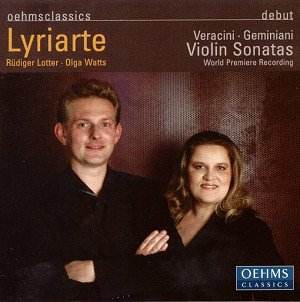These two young musicians
have constructed an equably balanced
programme of baroque sonatas, one that
gives the lion’s share to four of Geminiani’s
Op.4 set – not unreasonably since his
are probably less well known than Veracini’s
Op.1. The performances adhere to historically
informed practices and Lotter plays
a baroque set-up violin, as one would
expect of a fiddle player who has played
in Musica Antiqua Köln and under
Reinhard Goebel and René Jacobs.
He also maintained a dual role as a
member of the Munich Philharmonic but
now specialises in historical practice.
Moscow-born Olga Watts has collaborated
with Goebel as well, and with Frans
Brüggen and Thomas Hangerlbrock
and she has an increasing reputation
in music of this period.
They give a good account
of themselves in these six sonatas that
Oehms Classics rather strangely describes
on the booklet cover as World Premiere
Recording. I’m not sure if that
refers to the new group that Lotter
and Watts have formed, Lyriarte, or
whether they think that these pieces
have lain unrecorded all these years.
I assume the latter in which case they
may be right about some but not all.
Milstein recorded the Geminiani Op.4
No.10 in A major twice over, in 1959
and 1975. Sonya Monosoff recorded No.1
in D major. As for the two Veracinis;
Op.1 No. 7 has been recorded – famously
– by Grumiaux (twice) as well as by
Hyman Bress and by Piero Tosso; No.8
by the latter two violinists and also
by Giovanni Guglielmo. All of these
players were discographic pioneers in
this repertoire and they deserve a salute.
It would be good to hear Monosoff’s
Biber again – and to be aware that Bress
recorded the entire cycle of the Veracini
Op.1. The two Italian players were also
in the vanguard of exploration. Their
discs could certainly bear renewed interest
from some adventurous outfit.
So, that over, let’s
get on with Lotter and Watts. She fills
in the textures of the accompanying
figures of the Adagio of Geminiani’s
D major well, if a little busily. He
has a thin, though not pinched or under
nourished tone. He also avoids the line
bulges and swellings that can give "authentic"
performances such a bad name. His ornaments
here, and throughout the disc, are generally
apposite and unshowy. The Allegro second
movement of the same sonata is buoyant
and these are indeed very straightforward,
musical traversals. There are good dynamic
gradients in the C minor and once more
a good sense of aerial lift in its concluding
Allegro finale but it’s good to hear
Lotter dig into the second movement
of the D minor, exploring some rather
more abrasive sonorities, and giving
his lower strings some sustained exposure
in its finale. The two Veracini sonatas
go happily. The A major is by no means
outgunned by opposition, though it cleaves
to a more domestic line. The Largo has
a firm sense of line and both Allegros
of the B flat major are well characterised,
its Grave heart inward, though somewhat
cool.
The recorded sound
is bracing but attractive; no moribund
studio acoustic and no clinical separation
either. The notes are in German and
English. I suspect we will be having
complete sets of these two composers’
sonatas – I imagine Manze would bring
out the curvaceous and expressive heart
of the Veracinis in particular – but
this is, on its own terms, a good calling
card for these two younger musicians
in repertoire in which they clearly
feel at home.
Jonathan Woolf







